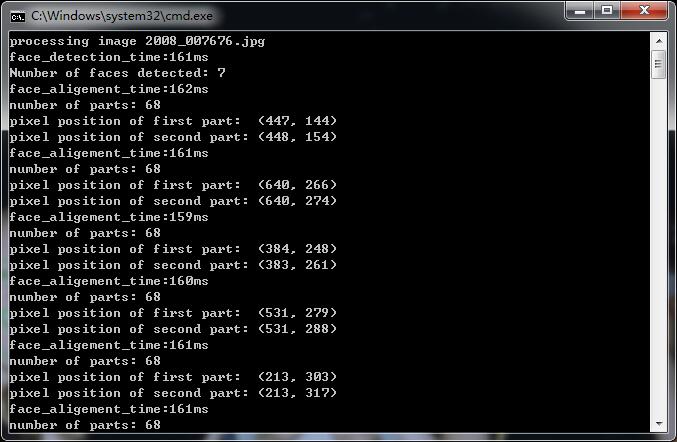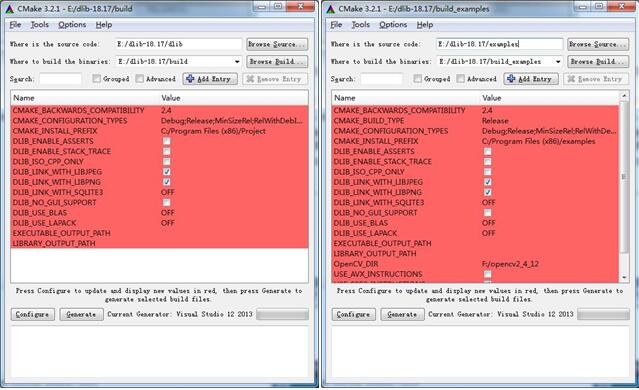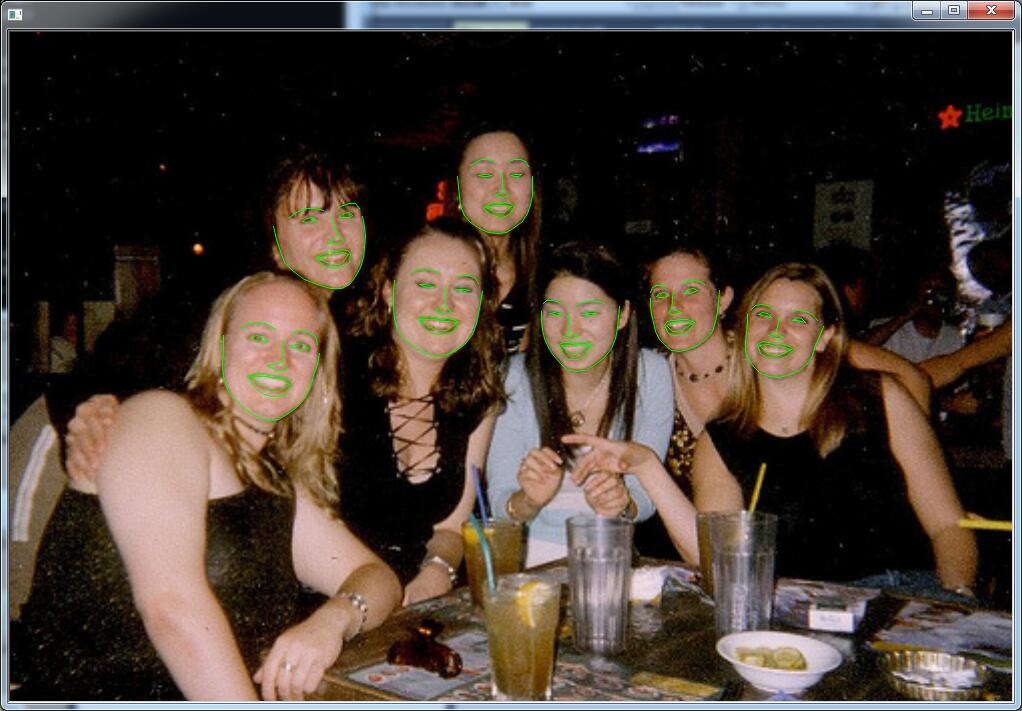Dlib人臉檢測+對齊
阿新 • • 發佈:2019-02-09
1,dlib庫的安裝
準備工具:
開始編譯,
這裡,需要使用cmake編譯2個東東,一個是dlib的庫,生成vs可以使用的.sln工程,另一個就是examples,同樣生成vs可以使用的.sln工程。
where is the source code 和where tobuild the binaries可以參考本人的配置,配置好後,點選Configure,選擇vs2013編譯器,完畢後,點選Generate,到此就可以在build路徑下生成Project.sln,build_examples路徑下生成examples.sln
用vs2013點選上面的sln分別開啟,然後選擇ALL_BUILD,右鍵生成即可。完畢後就可以生成,dlib.lib和各個examples的exe檔案。
2,人臉檢測+對齊
這裡檢測用的hog特徵進行的人臉檢測,本人測試是150MS的樣子,
對齊使用的是2014的cvpr,One Millisecond FaceAlignment with an Ensemble of Regression Trees by Vahid Kazemi and JosephineSullivan,對齊速度,本人測試也是150MS的樣子。
對齊效果還是很不錯的。
VS配置:
vc++目錄:
E:\dlib-18.17\
E:\dlib-18.17\dlib\external\libjpeg
C/C++,連結,輸入:
dlib.lib
程式程式碼:#define DLIB_JPEG_SUPPORT #include <dlib/image_processing/frontal_face_detector.h> #include <dlib/image_processing/render_face_detections.h> #include <dlib/image_processing.h> #include <dlib/gui_widgets.h> #include <dlib/image_io.h> #include <iostream> using namespace dlib; using namespace std; int main(int argc, char** argv) { argc = 3; argv[1] = "shape_predictor_68_face_landmarks.dat"; argv[2] = "2008_007676.jpg"; try { // This example takes in a shape model file and then a list of images to // process. We will take these filenames in as command line arguments. // Dlib comes with example images in the examples/faces folder so give // those as arguments to this program. if (argc == 1) { cout << "Call this program like this:" << endl; cout << "./face_landmark_detection_ex shape_predictor_68_face_landmarks.dat faces/*.jpg" << endl; cout << "\nYou can get the shape_predictor_68_face_landmarks.dat file from:\n"; cout << "http://dlib.net/files/shape_predictor_68_face_landmarks.dat.bz2" << endl; return 0; } // We need a face detector. We will use this to get bounding boxes for // each face in an image. frontal_face_detector detector = get_frontal_face_detector(); // And we also need a shape_predictor. This is the tool that will predict face // landmark positions given an image and face bounding box. Here we are just // loading the model from the shape_predictor_68_face_landmarks.dat file you gave // as a command line argument. shape_predictor sp; deserialize(argv[1]) >> sp; image_window win, win_faces; // Loop over all the images provided on the command line. for (int i = 2; i < argc; ++i) { cout << "processing image " << argv[i] << endl; array2d<rgb_pixel> img; load_image(img, argv[i]); // Make the image larger so we can detect small faces. pyramid_up(img); // Now tell the face detector to give us a list of bounding boxes // around all the faces in the image. clock_t start2, end2; start2 = clock(); std::vector<rectangle> dets = detector(img); end2 = (double)(1000 * (clock() - start2) / CLOCKS_PER_SEC); cout << "face_detection_time:" << end2 <<"ms"<< std::endl; cout << "Number of faces detected: " << dets.size() << endl; // Now we will go ask the shape_predictor to tell us the pose of // each face we detected. std::vector<full_object_detection> shapes; for (unsigned long j = 0; j < dets.size(); ++j) { clock_t start2, end2; start2 = clock(); std::vector<rectangle> dets = detector(img); full_object_detection shape = sp(img, dets[j]); end2 = (double)(1000 * (clock() - start2) / CLOCKS_PER_SEC); cout << "face_aligement_time:" << end2 <<"ms"<< std::endl; cout << "number of parts: " << shape.num_parts() << endl; cout << "pixel position of first part: " << shape.part(0) << endl; cout << "pixel position of second part: " << shape.part(1) << endl; // You get the idea, you can get all the face part locations if // you want them. Here we just store them in shapes so we can // put them on the screen. shapes.push_back(shape); } // Now let's view our face poses on the screen. win.clear_overlay(); win.set_image(img); win.add_overlay(render_face_detections(shapes)); // We can also extract copies of each face that are cropped, rotated upright, // and scaled to a standard size as shown here: dlib::array<array2d<rgb_pixel> > face_chips; extract_image_chips(img, get_face_chip_details(shapes), face_chips); win_faces.set_image(tile_images(face_chips)); cout << "Hit enter to process the next image..." << endl; cin.get(); } } catch (exception& e) { cout << "\nexception thrown!" << endl; cout << e.what() << endl; } }
實驗結果:

程式+論文下載連結:


